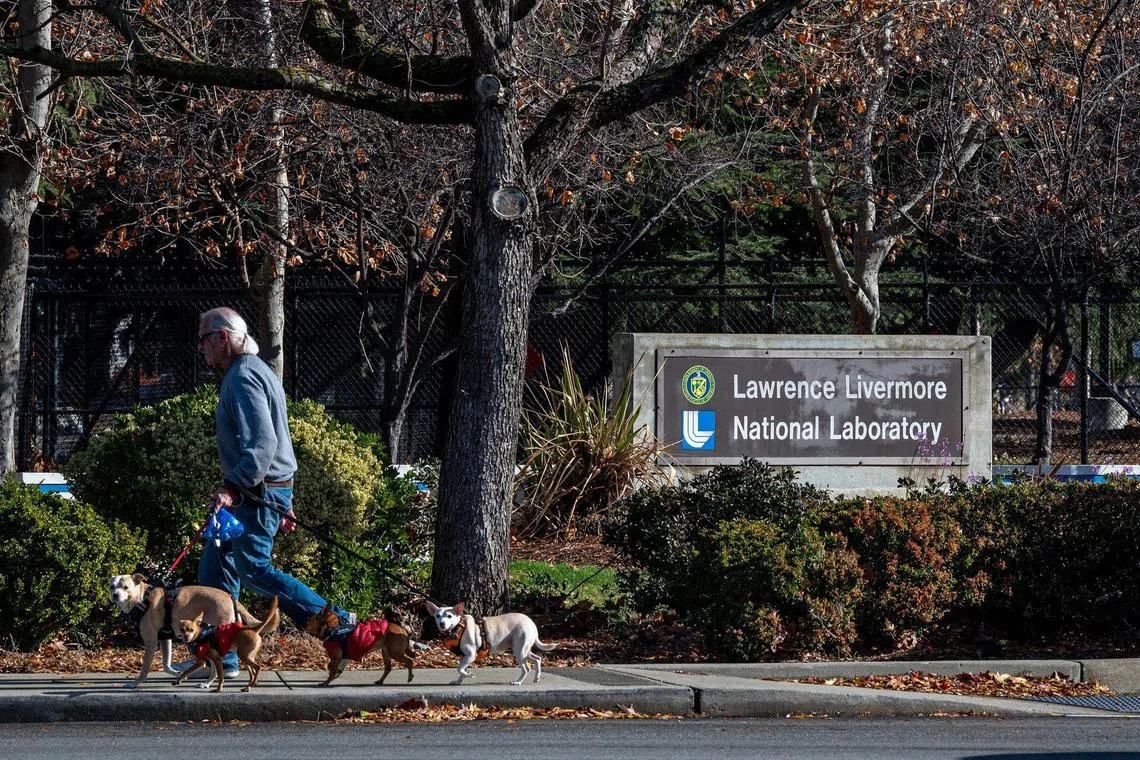What a breakthrough in nuclear fusion energy would mean
Sign up now: Get ST's newsletters delivered to your inbox

Scientists at the Lawrence Livermore National Laboratory are expected to announce their fusion test had net energy gain.
PHOTO: BLOOMBERG
Follow topic:
SAN FRANCISCO – Researchers are poised to announce a key breakthrough in nuclear fusion, an elusive technology that advocates have long said holds the promise of cheap, abundant carbon-free power.
Fusion has the potential to transform the global energy landscape, but there’s still a huge gap between this milestone and developing an actual power plant.
1. Why is this important?
Triggering a fusion reaction is an extremely complicated process requiring enormous amounts of energy.
Scientists at the US Department of Energy’s Lawrence Livermore National Laboratory near San Francisco are expected to announce that their fusion test had a net energy gain – that is, it produced more power than it consumed.
Scientists have been trying to achieve this for decades. The breakthrough creates the possibility of a system that would have enough energy to sustain a fusion reaction plus produce excess power that could be tapped and sold.
It demonstrates that fusion technology could eventually be used to generate electricity on a commercial scale.
2. How is fusion different from nuclear fission?
Nuclear power comes in two very different versions: fission, which splits atoms apart, and fusion, which melds them together. The nuclear reactors used since the 1950s for generating electricity all employ fission, as did the original atomic bomb.
Reactors typically produce a large, steady supply of electricity day and night, for months on end until they need refueLling. Unfortunately, they also produce radioactive waste that’s deadly for thousands of years and needs to be carefully stored, either on-site on in centralized repositories.
Fusion energy, by contrast, is the power source of stars, whose immense gravity crushes together atoms of hydrogen to form helium. With fusion, there’s no long-lived radioactive waste.
3. Why is fusion so difficult?
Experiments with fusion go back almost as far as those with fission, with the first fusion bomb detonated by the US in 1952. But explosions are one thing: A stable, controlled reaction that can run a power plant is quite another.
The process of fusing atoms together takes an enormous amount of energy, both to achieve the reaction and contain it. And until now, all methods to produce fusion in the lab have required more energy than the reaction itself created. Plus, high-energy neutrons generated by the reaction can damage the equipment.
Still, many people are trying to make it work. A coalition of 35 governments, working together in a programme called ITER, is building a reactor in France using a “tokamak” design that dates back to the Soviet Union.
It uses lasers and powerful electromagnets arrayed around a super-cooled doughnut-shaped container, holding hot ionized gas. China is a member of ITER but is working on its own system as well, with a goal of sustainable fusion by 2040.
Private companies are trying their own designs, with backings from high-profile investors including Jeff Bezos, Bill Gates and Peter Thiel.
4. What challenges remain?
It’s still a long way from the breakthrough in California to building a fusion-based power plant. While this experiment generated excess energy on a small scale, the industry needs to develop systems that can produce much more excess energy, and on a much larger scale.
A net energy gain shows that the concept will work, but the systems are still complicated and expensive. This test used some of the most powerful lasers ever built, and they aren’t readily available for commercial power plants. The industry still needs to do a lot of work to make the technology widely available and affordable.
5. Who will benefit from this achievement?
There are numerous companies pursuing fusion, and there are several different approaches. They’re going to need significant capital as they seek to commercialise the technology, and this achievement may generate excitement among potential investors.
Startups including Commonwealth Fusion Systems and Helion Energy attracted US$2.3 billion (S$3.1 billion) in support in 2021, and backers will likely direct more than US$1 billion to the field this year, according to BloombergNEF. Other notable companies include Marvel Fusion, TAE Technologies, General Fusion, Tokamak Energy and Zap Energy. Bloomberg

